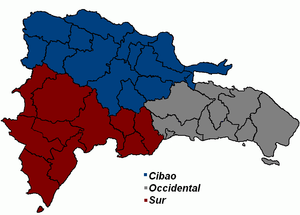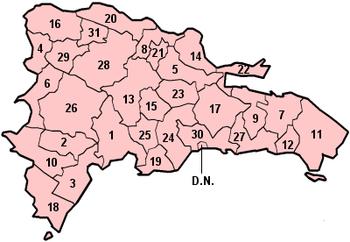- Cibao
-
El Cibao Country Dominican Republic Area – Total 19,058.62 km2 (7,358.6 sq mi) Population (2009) – Total 5,622,378. – Density 295/km2 (764/sq mi) Cibao, usually referred as "El Cibao", is a region of the Dominican Republic located at the northern part of the country.
The Taíno word Cibao, meaning "place where rocks abound", was originally applied to the central mountain range, and used during the Spanish conquest to refer to the rich and fertile valley between the Central and Septentrional mountain ranges.
Geography and Economy
The Cibao region occupies the whole northern part of the Dominican territory. To the north and east of the region lies the Atlantic Ocean; to its west lies the Republic of Haiti and to the south the Central Range, which separates Cibao from the other natural regions. The cibao has a population of 5,622,378 in 2009.
Province Capital Area (km²)[1] Population[1] Density[1] Map region Dajabón Dajabón 1,020.73 62,046 61 4 Duarte San Francisco de Macorís 1,605.35 283,805 177 5 Espaillat Moca 838.62 225,091 268 8 Hermanas Mirabal Salcedo 440.43 96,356 219 21 La Vega Concepción de la Vega 2,287.24 385,101 168 13 María Trinidad Sánchez Nagua 1,271.71 135,727 119 14 Monseñor Nouel Bonao 992.39 167,618 169 15 Monte Cristi San Fernando de Monte Cristi 1,924.35 111,014 58 16 Puerto Plata San Felipe de Puerto Plata 1,852.90 312,706 168 20 Samaná Santa Bárbara de Samaná 853.74 91,875 108 22 Sánchez Ramírez Cotuí 1,196.13 151,179 126 23 Santiago Santiago de los Caballeros 2,836.51 908,250 320 28 Santiago Rodríguez San Ignacio de Sabaneta 1,111.14 59,629 54 29 Valverde Santa Cruz de Mao 823.38 158,293 192 31 Total 19,058.62 3,148,690 165 - The population is mainly gathered in the center of the region. The city of Santiago de los Caballeros constitutes the regional center and main focus of development of the area.
Two of the largest rivers of the country are located inside this region: the Yaque del Norte, the largest river of the Dominican Republic, and the Yuna river. Both of these rivers contain several chains of dams used to provide the region with water for irrigation (since agriculture is the main activity of the area) and hydroelectric energy. Rice, coffee and cacao are the most important crops grown in the area.
The central mountain range also has important mining activity. Its main mineral resources include gold, iron and nickel, among others. The internationally known Falconbridge is the company in charge of the extraction of these ores.
The Atlantic coast of the country is well known for having beautiful beaches. Several tourist centers have developed along the coast of the region, among them Sosúa, originally a very small Jewish community established in the 1940s; Cabarete, one of the most important centers in the Caribbean for international surfing competitions; and most recently Samaná, ideal for eco-tourism and whale watching.
Culture
The valley is not only a geographical unit, but also a cultural and linguistic unit. A typical dialect of Spanish is spoken in the area, including several regional idiomatic phrases, expressions, and a particular way of speaking. A "cibaeño" can be identified because of his substitution of the "R" and "L" phonetic sounds at the end of syllables for short "I" sounds while speaking. Many linguistics are suggesting that the Spanish dialect that is being spoken in the area, can be classified as a Creole language.
The genre of Merengue is played using the Güira, Tambora (drum) and Accordion, originates in the Cibao region. This type of merengue is played by the Perico Ripiao, which are typical local musical groups. This latter name is also often used to refer to the musical genre itself.
During Late January and through February, several carnivals are held within the region. The most popular of these festivals belongs to the province of La Vega, and dates back to the first European settlements. It began as a religious activity celebrating the pre-Lent season, and the carnival's theme revolves around the victory of good over evil.
Many important Dominican patriots were of cibaeño origin. Among the most important are local generals Santiago Rodríguez and Gregorio Luperón, who were responsible for the restoration of the Republic in the later decades of the 1800s. During the Trujillo dictatorship, the Mirabal sisters arranged clandestine organizations to rebel against the anarchy. The sisters were brutally murdered in 1960, and remain today as some of the biggest martyrs on behalf of the Dominican nation.
References
- ^ a b c Oficina Nacional de Estadística. "República Dominicana en Cifras 2006" (in Spanish) (PDF). http://www.one.gob.do/index.php?option=com_docman&task=doc_download&gid=326. Retrieved 2007-03-27.
Categories:- Regions of the Dominican Republic
Wikimedia Foundation. 2010.


